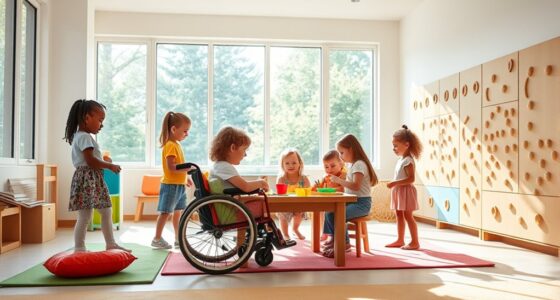When your child says “I’m bored,” use it as a chance to encourage their creativity and emotional resilience. Offer open-ended supplies like art materials or household items to inspire independent thinking. Instead of rushing to distract, guide them to explore calm activities or reflect on their feelings. This builds patience, self-control, and problem-solving skills. If you keep exploring these approaches, you’ll discover effective ways to turn boredom into valuable growth moments.
Key Takeaways
- Encourage open-ended creative activities to promote problem-solving, innovation, and emotional expression during boredom.
- Use boredom as a teaching moment to build patience, self-regulation, and emotional resilience.
- Establish routines like quiet time or reflection periods to normalize unstructured moments.
- Guide children in exploring new crafts or self-directed projects to foster independence and creativity.
- Model calm, patient responses and avoid rushing to distract, helping children develop self-control and emotional skills.

Kids often say “I’m bored” when they don’t have enough engaging activities to fill their time, and as a parent or caregiver, it can be frustrating to hear. But rather than rushing to provide the next distraction, consider this an opportunity to help your child develop valuable skills. One effective way to do this is by encouraging creative activities. When children are given open-ended supplies like art materials, building blocks, or even simple household items, they learn to think creatively and problem-solve on their own. These activities not only keep them occupied but also foster independence and innovation. Plus, engaging in creative play helps children process their emotions, build confidence, and discover new interests. Instead of simply telling them to stop whining and find something to do, guide them to create something unique or explore a new craft. This approach keeps their minds active and nurtures their natural curiosity.
In addition to sparking creativity, using boredom as a teaching moment strengthens emotional resilience. When kids face moments of boredom, they learn to manage their feelings and become comfortable with quiet or unstimulating periods. You can help them see these moments as chances to develop patience and self-control. For example, suggest they sit with their boredom for a few minutes and reflect on what they might want to do next, or encourage them to find a calming activity like drawing or deep breathing. Over time, these experiences teach children that they can handle periods of waiting or unstructured time without becoming overwhelmed. This resilience becomes a crucial skill that benefits them in school, friendships, and future challenges.
To make the most of these moments, you can also introduce simple routines that promote emotional resilience. For instance, establish a daily “quiet time” where children are encouraged to sit with their thoughts or read a book. Use prompts that help them explore their feelings, like asking, “What are you feeling right now?” or “What would you like to do instead?” These conversations teach children to recognize and regulate their emotions, making boredom less intimidating. Remember to model this behavior yourself too—share your own moments of patience or creative problem-solving. When children see adults handling boredom calmly and constructively, they learn to emulate those skills.
Frequently Asked Questions
How Can Parents Encourage Autonomous Play During Boredom?
You can encourage autonomous play during boredom by providing open-ended materials like art supplies, building blocks, or costumes that invite imaginative exploration. Offer opportunities for self-directed activities, allowing your child to choose what interests them. Step back and resist the urge to over-schedule, giving them space to invent games and stories. This fosters independence, creativity, and problem-solving skills, helping them learn to entertain themselves and develop confidence in their abilities.
What Are Effective Ways to Teach Kids to Manage Boredom?
You can teach kids to manage boredom by practicing mindful listening and emotional coaching. When they express boredom, listen carefully without judgment, helping them identify what they’re feeling. Encourage them to explore their emotions and brainstorm activities that interest them. This approach builds resilience and self-awareness, empowering kids to handle boredom independently. By guiding them calmly, you foster their emotional skills and promote creative, autonomous problem-solving.
How Does Boredom Contribute to a Child’s Creativity?
Think of boredom as a quiet forest clearing, inviting your child’s creative sparks to ignite. When kids face boredom, they become explorers, seeking new paths and solutions. This natural pause fuels problem solving and sparks originality, turning dull moments into opportunities for inventive thinking. By embracing boredom, you help your child develop resilience and resourcefulness, *unleashing* their imaginative potential and transforming idle time into a fertile ground for creativity to flourish.
What Are Common Misconceptions About Kids and Boredom?
Many people believe that boredom leads to misbehavior, but that’s a myth. In reality, boredom can encourage kids to explore and be creative. The myth vs. reality about boredom and behavior shows that boredom isn’t a problem to eliminate but an opportunity for growth. When kids are bored, they often develop problem-solving skills and resilience, helping them learn how to entertain themselves and manage their feelings better.
How Can Caregivers Balance Guidance and Independence?
Did you know that children who experience balanced independence tend to develop better problem-solving skills? To foster this, practice mindful guidance by setting clear, gentle boundaries, allowing your child space for independent exploration. Encourage their curiosity and give them age-appropriate choices, while staying supportive. This balance helps your child build confidence and resilience, preparing them for future challenges without feeling overwhelmed or overly controlled.
Conclusion
When your child says “I’m bored,” it’s easy to see it as a problem. But it’s actually an opportunity—an invitation to foster creativity and independence. Instead of rushing to entertain, you give them space to explore and imagine. Boredom might feel uncomfortable, but it’s often where growth begins. Embrace those moments, knowing they can lead to skills and confidence that last far beyond the initial boredom.










